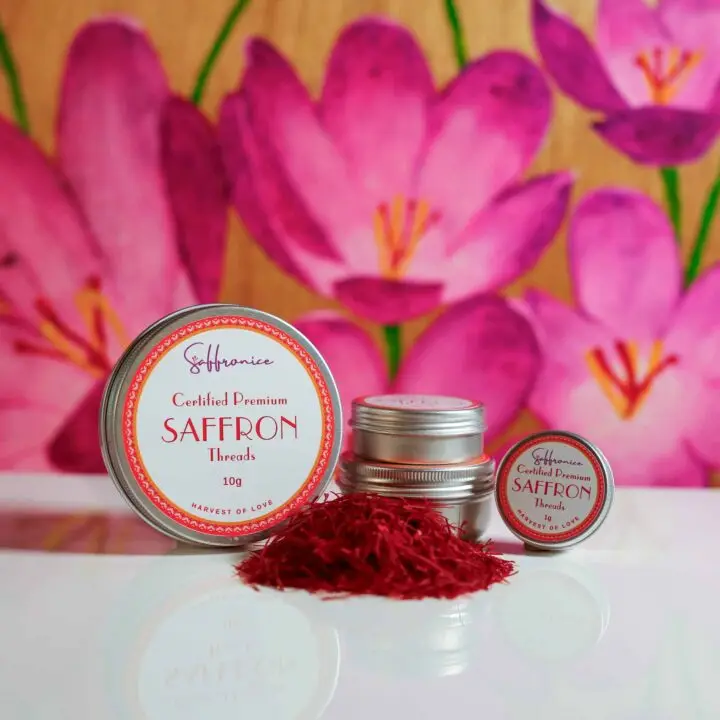In the world of natural remedies, few ingredients possess the rich history and therapeutic versatility of saffron. This precious spice, derived from the delicate crimson stigmas of the Crocus sativus flower, has long been revered for its remarkable ability to support various aspects of human health—particularly vision. As modern science delves deeper into saffron’s properties, it unveils compelling evidence for how this ancient botanical can naturally assist in maintaining and enhancing eye health.
Saffron’s use in traditional medicine and cultural practices dates back millennia, with its vision-supporting capabilities celebrated across diverse civilizations. From ancient Persia to traditional Chinese and Ayurvedic systems, saffron has been recognized for promoting clear, sharp vision and protecting against age-related eye concerns. Now, as researchers explore the science behind saffron’s benefits, a growing body of evidence suggests this spice’s unique compounds may hold the key to optimal visual function.
🔑 Key Takeaways:
- Saffron has over 3,000 years of documented use for supporting eye health across multiple cultures
- Contains powerful carotenoids (crocin, crocetin) and antioxidants that protect retinal cells
- Clinical studies show promising results for age-related macular degeneration (AMD)
- Recommended dosage of 20-30mg daily demonstrates safety and efficacy
- Natural approach to supporting vision with minimal side effects

Understanding Saffron’s Historical Role in Eye Health
Saffron’s relationship with eye health represents one of medicine’s most enduring therapeutic applications. The historical journey of this precious spice reveals sophisticated understanding of ocular health across ancient civilizations, long before modern ophthalmology emerged.
Ancient Medicinal Uses of Saffron
In ancient Persia, saffron served as a potent medicinal ingredient, with records dating back to 3000 BCE indicating its use for treating various conditions, including eye disorders. Persian physicians documented saffron’s ability to improve blood flow and protect against oxidative damage—concepts remarkably aligned with contemporary scientific understanding. The spice’s antioxidant properties and circulation-enhancing effects were believed particularly beneficial for maintaining optimal eye health.
Similarly, traditional Ayurvedic medicine prized saffron for its capacity to sharpen vision and alleviate vision-related problems. Ancient texts describe saffron as “netra hitam” (beneficial for the eyes), recommending it for conditions ranging from poor night vision to inflammatory eye diseases.
Food Scientist’s Note: Ancient physicians lacked modern analytical tools, yet their observations of saffron’s vision-supporting effects align remarkably with current research on its carotenoid content and antioxidant mechanisms. This consistency across cultures suggests genuine therapeutic properties rather than mere folklore.
Traditional Vision Enhancement Practices
Different civilizations developed unique applications for saffron in eye care:
Ancient Greece: Physicians prepared saffron-based eye drops and ointments to treat conditions like conjunctivitis and cataracts. Greek medical texts describe detailed formulations combining saffron with other herbs for specific ocular conditions.
Traditional Chinese Medicine: TCM incorporated saffron into formulations aimed at improving eyesight and protecting eyes from sunlight damage. Chinese herbalists classified saffron as beneficial for “liver blood” deficiency, which they associated with vision problems.
Mediterranean Region: Saffron was regularly added to foods and beverages with the belief that its antioxidants could enhance visual acuity and prevent age-related vision decline. This prophylactic approach reflects sophisticated understanding of preventive medicine.
The convergence of these independent traditions provides compelling evidence for saffron’s genuine therapeutic value in maintaining eye health—knowledge that modern science continues to validate and expand upon.
The Science Behind Saffron for Vision
Contemporary research has illuminated the mechanisms underlying saffron’s vision-supporting properties, revealing how this ancient remedy works at cellular and molecular levels. The scientific community has identified specific compounds responsible for saffron’s remarkable effects on ocular health.
Mechanisms of Action
Saffron’s vision-enhancing properties operate through multiple complementary pathways:
Antioxidant Protection: Saffron’s powerful antioxidants neutralize harmful free radicals that damage retinal cells through oxidative stress. This protection is particularly crucial given the retina’s high metabolic activity and constant light exposure, which generate significant oxidative challenges.
Anti-inflammatory Effects: Chronic inflammation contributes significantly to age-related vision deterioration. Saffron’s anti-inflammatory properties help reduce inflammatory processes in ocular tissues, slowing degenerative changes.
Enhanced Blood Flow: Improved circulation to ocular tissues ensures adequate oxygen and nutrient delivery while facilitating waste removal. This vascular support proves particularly important for maintaining healthy retinal function.
Neuroprotection: Saffron compounds exhibit neuroprotective effects, safeguarding retinal neurons from damage and potentially supporting their regeneration. This property addresses vision loss at its cellular source.
Research on Carotenoids and Vision
Studies have demonstrated strong correlations between saffron’s carotenoid content and improved visual parameters:
| Compound | Primary Vision Benefits | Mechanism of Action |
|---|---|---|
| Crocin | Protects retinal cells, improves light sensitivity | Powerful antioxidant, anti-apoptotic effects |
| Crocetin | Enhances visual contrast, supports retinal function | Anti-inflammatory, improves microcirculation |
| Safranal | Neuroprotective effects, retinal cell preservation | Reduces oxidative stress, modulates neurotransmitters |
The synergy between these compounds creates comprehensive ocular protection, addressing multiple factors that contribute to vision deterioration.
Key Compounds in Saffron That Support Eye Health
Saffron contains an extraordinarily complex phytochemical profile, with several compounds demonstrating specific benefits for eye health. Understanding these constituents helps explain the spice’s remarkable therapeutic versatility.
Crocin and Crocetin Benefits
Crocin, the primary carotenoid in saffron, plays a vital role in enhancing vision by protecting retinal cells from oxidative stress—a significant contributor to age-related macular degeneration (AMD) progression. Research suggests crocin may improve visual function and potentially support regeneration of damaged retinal cells.
Crocetin, structurally similar to crocin but with enhanced bioavailability, has been linked to pronounced anti-inflammatory properties. This compound provides additional support in maintaining eye health and mitigating conditions associated with AMD. The synergy between these two carotenoids makes saffron a compelling candidate for dietary interventions aimed at preserving vision.
Clinical Evidence: A study published in Investigative Ophthalmology & Visual Science found that crocin supplementation improved macular pigment density in AMD patients, correlating with enhanced visual function and reduced photoreceptor degeneration.
Antioxidant Properties
Saffron’s antioxidant compounds play crucial roles in protecting eyes from damaging effects of free radicals and oxidative stress. These antioxidants neutralize harmful reactive oxygen species, reducing risk of age-related macular degeneration, cataracts, and other degenerative eye conditions.
The combination of water-soluble (crocin) and lipid-soluble (crocetin) antioxidants provides comprehensive protection across different cellular compartments and tissue types within the eye. This dual-phase antioxidant capacity distinguishes saffron from many other protective nutrients.
Carotenoid Content and Macular Health
Saffron contains carotenoids structurally similar to lutein and zeaxanthin—well-established eye health nutrients. These compounds accumulate in the macula, the retinal region responsible for central vision and fine detail perception.
Macular Protection Mechanisms:
- Filter high-energy blue light that damages photoreceptors
- Provide additional antioxidant protection at the macula
- Support macular pigment density, crucial for visual acuity
- Reduce glare sensitivity and improve contrast perception
By incorporating saffron into the diet, individuals can potentially support macular health through the synergistic effects of its unique carotenoid profile. This natural approach complements other vision-supporting nutrients while offering additional therapeutic benefits through saffron’s distinctive compound composition.
Food Scientist’s Note: Unlike synthetic supplements, whole saffron provides carotenoids in their natural matrix with cofactors that may enhance absorption and utilization. This “food matrix effect” potentially explains why saffron supplementation shows robust benefits in clinical trials.
Saffron’s Impact on Age-Related Macular Degeneration
Age-related macular degeneration (AMD) represents the leading cause of vision loss in adults over 50. Emerging research suggests saffron may offer significant benefits for managing this debilitating condition, providing hope for millions affected worldwide.
Clinical Evidence for AMD
Multiple studies have explored saffron’s potential to slow AMD progression and improve visual function:
Italian Clinical Trial: Research conducted in Italy found that supplementation with 20mg saffron daily improved contrast sensitivity and reading ability in individuals with early-stage AMD. Participants experienced measurable enhancements in visual acuity after just three months of supplementation. Researchers attributed these benefits to saffron’s powerful antioxidant and anti-inflammatory properties protecting delicate retinal cells.
Journal of Ophthalmology Study: A six-month trial reported that daily saffron supplementation resulted in significantly improved visual function in AMD patients. Researchers noted that saffron’s unique carotenoids—particularly crocin and crocetin—played key roles in preserving retinal health and enhancing light sensitivity.
Long-term Follow-up Research: Extended studies tracking patients over 12-24 months demonstrated sustained benefits with continued saffron use, suggesting cumulative protective effects rather than temporary improvements.
| Study Duration | Dosage | Key Outcomes | Patient Population |
|---|---|---|---|
| 3 months | 20mg daily | Improved contrast sensitivity, reading ability | Early-stage AMD |
| 6 months | 30mg daily | Enhanced visual acuity, retinal function | Moderate AMD |
| 12 months | 20mg daily | Sustained vision improvements, slowed progression | Mixed AMD stages |
Mechanisms in AMD Protection
Saffron addresses AMD through multiple therapeutic pathways:
Oxidative Stress Reduction: AMD progression involves significant oxidative damage to retinal pigment epithelium and photoreceptors. Saffron’s antioxidants intercept free radicals before they cause cellular damage.
Inflammatory Modulation: Chronic inflammation drives AMD pathology. Saffron reduces inflammatory markers and modulates immune responses in retinal tissues.
Improved Retinal Circulation: Enhanced blood flow delivers nutrients and oxygen while removing metabolic waste products, supporting cellular health and function.
Photoreceptor Protection: Direct neuroprotective effects on rod and cone cells help preserve light-sensing capabilities crucial for vision.
These complementary mechanisms provide comprehensive support for individuals concerned about AMD, offering a natural approach to managing this progressive condition.

How Saffron Protects Against Vision Loss
Beyond specific conditions like AMD, saffron offers broad protective effects that support overall visual health and function throughout the lifespan.
Retinal Cell Protection
The retina, light-sensitive tissue at the eye’s back, plays the crucial role in vision. Saffron’s active compounds—particularly crocin and crocetin—demonstrate remarkable ability to protect retinal cells from multiple threats:
Oxidative Damage Prevention: By neutralizing free radicals generated by light exposure and metabolic processes, saffron prevents cumulative cellular damage that leads to vision deterioration.
Apoptosis Reduction: Research shows saffron compounds reduce programmed cell death (apoptosis) in retinal cells, preserving functional photoreceptors and supporting cells.
Cellular Energy Support: Saffron helps maintain mitochondrial function in retinal cells, ensuring adequate energy production for demanding visual processes.
Light Sensitivity Enhancement
Saffron has been shown to enhance light sensitivity—a crucial factor in maintaining clear, vibrant vision across varying lighting conditions. This property helps individuals adapt more effectively to brightness changes, reducing visual impairment risk and improving overall visual contrast.
Practical Benefits:
- Improved night vision and low-light visual acuity
- Reduced glare sensitivity when transitioning between lighting conditions
- Enhanced ability to discern details in challenging visual environments
- Better adaptation to varying light levels throughout the day
The combined effects of retinal cell protection and light sensitivity enhancement contribute significantly to saffron’s role in safeguarding vision. As a natural, well-tolerated supplement, saffron offers a promising avenue for individuals seeking to maintain eye health and prevent vision loss.
Optimal Dosage and Supplementation Guidelines
Understanding appropriate dosing and supplementation strategies maximizes saffron’s vision-supporting benefits while ensuring safety and tolerability.
Recommended Daily Intake
For adults seeking to improve or maintain healthy vision, recommended daily intake typically ranges between 20-30 milligrams. This dosage, validated as safe and effective in numerous studies, provides necessary support for retinal function and light sensitivity enhancement.
Dosing Considerations:
Standard Prevention: 20mg daily for maintaining eye health and reducing AMD risk Active Support: 25-30mg daily for individuals with early-stage vision concerns Therapeutic Use: Up to 30mg daily under healthcare professional guidance for diagnosed conditions
Optimal dosage may vary based on factors including age, existing eye conditions, overall health status, and individual response. Individuals with macular degeneration or other vision-related concerns may require slightly higher doses under professional supervision.
Food Scientist’s Note: Consistency matters more than exact dosing. Taking saffron regularly at the same time each day optimizes bioavailability and maintains steady blood levels of active compounds.
Best Forms of Supplementation
Various saffron supplementation options offer different advantages:
Capsules or Tablets: The most convenient and widely available form, offering standardized doses of active compounds. Look for products specifying crocin and crocetin content.
Saffron Extracts: Concentrated extracts in liquid or soft-gel capsules provide higher bioavailability of active compounds, potentially offering enhanced benefits. These typically use specialized extraction methods preserving delicate constituents.
Saffron-Infused Foods and Beverages: Incorporating saffron into teas or culinary dishes can contribute to overall intake while offering additional enjoyment. However, achieving therapeutic doses through food alone may be challenging.
Combination Formulas: Some supplements combine saffron with complementary eye health nutrients like lutein, zeaxanthin, and omega-3 fatty acids for synergistic effects.
When selecting supplements, choose high-quality, reputable brands ensuring purity, potency, and safety. Third-party testing verification provides additional confidence in product quality.
Combining Saffron with Other Eye Health Nutrients
Saffron’s benefits can be amplified through strategic combination with other vision-supporting nutrients, creating comprehensive eye health protocols.
Synergistic Nutrient Combinations
Saffron and Lutein/Zeaxanthin: These carotenoids work synergistically to enhance macular pigment density, improving visual acuity and contrast sensitivity. The combination provides multi-layered protection:
- Saffron’s crocin and crocetin complement lutein’s blue light filtering
- Combined antioxidant effects exceed individual compounds
- Different mechanisms target multiple AMD pathways
- Enhanced overall macular protection
Saffron and Omega-3 Fatty Acids: Fish oil omega-3s support retinal function, reduce inflammation, and promote tear production—all crucial for optimal visual performance. When combined with saffron:
- Anti-inflammatory effects are magnified
- Membrane fluidity in photoreceptor cells improves
- Neuroprotection extends throughout retinal layers
- Dry eye symptoms may be reduced
Saffron and Vitamin C/E: These classic antioxidant vitamins complement saffron’s protective effects by working in different cellular compartments and through distinct mechanisms.
Creating comprehensive supplement regimens addressing various vision protection aspects helps support long-term eye health and potentially mitigates age-related vision problem risks.
Potential Side Effects and Precautions
While saffron is generally well-tolerated, understanding potential side effects and necessary precautions ensures safe, effective use.
Safety Considerations
Saffron is considered safe for most adults when taken in recommended doses (20-30mg daily). However, certain populations should exercise caution:
Pregnancy and Nursing: Pregnant women should avoid therapeutic saffron doses, as the spice may stimulate uterine contractions. Safety during nursing hasn’t been fully established.
Children: Pediatric safety data remains limited. Consult pediatric healthcare providers before giving saffron supplements to children.
High-Dose Effects: Doses exceeding 5 grams may cause adverse effects including nausea, vomiting, dizziness, and headaches. Always adhere to recommended dosing guidelines.
Allergic Reactions: Though rare, some individuals may experience allergic responses. Discontinue use if you notice rash, itching, or breathing difficulties.
Drug Interactions
Saffron may interact with certain medications, requiring professional consultation:
Blood Thinners: Saffron may enhance anticoagulant effects of warfarin and similar medications, increasing bleeding risk.
Diabetes Medications: Saffron can lower blood sugar, potentially requiring insulin or oral medication dosage adjustments.
Antidepressants: Interactions with SSRIs and other antidepressants may occur due to saffron’s effects on serotonin levels.
Blood Pressure Medications: Saffron may lower blood pressure, potentially requiring medication adjustments.
Always discuss saffron supplementation with healthcare providers if taking prescription medications. They can provide guidance on appropriate dosing and timing to ensure safety and avoid potential complications.
Choosing Quality Saffron Supplements
Supplement quality directly impacts therapeutic efficacy and safety. Not all saffron products deliver equivalent benefits, making informed selection crucial.
Quality Indicators
Standardization: Look for supplements standardized to specific concentrations of crocin and crocetin—the primary active compounds. Products should clearly state these concentrations on labels.
Third-Party Testing: Choose products tested by independent laboratories for purity, potency, and contamination. Certifications from organizations like USP, NSF, or ConsumerLab provide assurance.
Extraction Methods: Quality supplements use gentle extraction processes preserving delicate bioactive compounds. Avoid products using harsh chemicals or excessive heat.
Transparency: Reputable manufacturers provide detailed information about sourcing, processing methods, and testing protocols. Lack of transparency should raise concerns.
Avoiding Counterfeit Products
The saffron supplement market unfortunately includes adulterated and counterfeit products. Protect yourself by:
- Purchasing from reputable sources with established track records
- Being skeptical of prices significantly below market rates
- Checking for proper labeling including botanical name, dosage, and manufacturer information
- Reading customer reviews and third-party testing reports
- Verifying batch-specific certificates of analysis when available
Investing in quality supplements ensures you receive genuine therapeutic benefits rather than ineffective or potentially harmful substitutes.
Conclusion
Saffron’s journey from ancient remedy to evidence-based vision support demonstrates the enduring value of traditional medicinal wisdom validated through modern scientific inquiry. The convergence of millennia-old therapeutic applications with contemporary clinical research creates compelling rationale for incorporating this precious spice into comprehensive eye health strategies.
The key bioactive compounds in saffron—particularly crocin, crocetin, and safranal—work synergistically to shield retinal cells, enhance light sensitivity, and provide potent antioxidant protection. Multiple clinical studies demonstrate measurable improvements in visual function, particularly for individuals with age-related macular degeneration.
Incorporating 20-30mg of quality saffron daily represents a valuable addition to holistic eye health approaches, complementing balanced nutrition and other supportive nutrients. The natural compound’s excellent safety profile and minimal side effects make it accessible for most adults seeking vision support.
As research continues expanding our understanding of saffron’s ocular benefits, this ancient spice stands poised to play an increasingly important role in preventive and therapeutic approaches to vision health. Whether you’re concerned about age-related vision changes or simply seeking to maintain optimal eye function, saffron offers a time-tested, scientifically validated natural solution.
For comprehensive information about saffron’s wide-ranging health benefits beyond vision support, explore additional research on this remarkable botanical medicine.
FAQ
What are the key compounds in saffron that support eye health?
The primary compounds supporting eye health are crocin, crocetin, and safranal. These possess potent antioxidant properties protecting delicate eye tissues from oxidative damage. Saffron also contains carotenoids structurally similar to lutein and zeaxanthin, essential for maintaining healthy macular function and filtering harmful blue light.
How can saffron help with age-related macular degeneration (AMD)?
Research demonstrates that saffron may slow AMD progression, the leading cause of vision loss in older adults. Studies show saffron’s antioxidant and anti-inflammatory properties protect retinal cells and improve visual acuity in AMD patients. Clinical trials report improvements in contrast sensitivity, reading ability, and overall visual function with daily saffron supplementation.
What is the recommended dosage for saffron supplements for eye health?
The recommended daily intake typically ranges between 20-30mg for vision support. This dosage has proven safe and effective in clinical studies. However, optimal dosing may vary based on age, existing eye conditions, and individual response. Consult healthcare professionals to determine appropriate dosage for your specific needs.
Can saffron be combined with other eye health supplements?
Yes, saffron combines effectively with other vision-supporting nutrients including lutein, zeaxanthin, and omega-3 fatty acids. These compounds work synergistically, providing comprehensive eye protection. The combination addresses multiple pathways of vision deterioration and may offer superior benefits compared to single-ingredient supplementation.
Are there potential side effects or precautions with saffron supplements?
Saffron is generally well-tolerated at recommended doses (20-30mg daily). High doses may cause headache, nausea, or dizziness. Pregnant women should avoid therapeutic doses due to potential uterine stimulation. Individuals with bleeding disorders, taking blood thinners, diabetes medications, or antidepressants should consult healthcare providers before use due to potential interactions.



